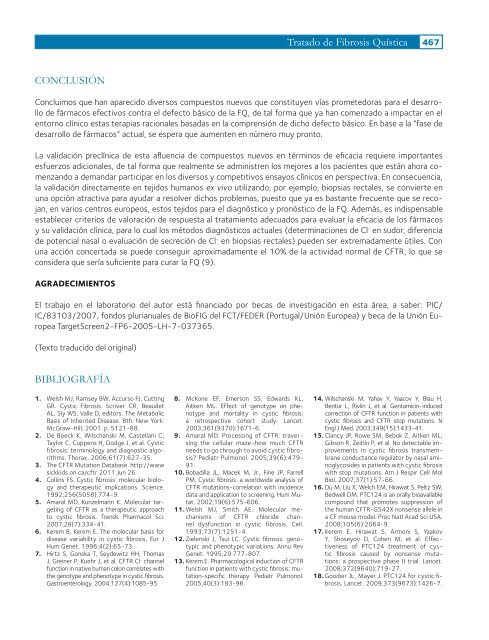tratado_fibro_quistica
tratado_fibro_quistica
tratado_fibro_quistica
Create successful ePaper yourself
Turn your PDF publications into a flip-book with our unique Google optimized e-Paper software.
Tratado de Fibrosis Quística<br />
467<br />
CONCLUSIÓN<br />
Concluimos que han aparecido diversos compuestos nuevos que constituyen vías prometedoras para el desarrollo<br />
de fármacos efec tivos contra el defecto básico de la FQ, de tal forma que ya han comenzado a impactar en el<br />
entorno clínico estas terapias racionales basadas en la comprensión de dicho defecto básico. En base a la “fase de<br />
desarrollo de fármacos” actual, se espera que aumenten en número muy pronto.<br />
La validación preclínica de esta afluencia de compuestos nuevos en términos de eficacia requiere importantes<br />
es fuerzos adicionales, de tal forma que realmente se administren los mejores a los pacientes que están ahora comenzando<br />
a demandar participar en los diversos y competitivos ensayos clínicos en perspectiva. En consecuencia,<br />
la validación directamente en tejidos humanos ex vivo utilizando, por ejemplo, biopsias rectales, se convierte en<br />
una opción atractiva para ayudar a resolver dichos problemas, puesto que ya es bastante frecuente que se recojan,<br />
en varios centros europeos, estos tejidos para el diagnóstico y pronóstico de la FQ. Además, es indispensable<br />
establecer criterios de valoración de respuesta al tratamiento adecuados para evaluar la eficacia de los fármacos<br />
y su validación clínica, para lo cual los métodos diagnósticos actuales (determinaciones de Cl - en sudor, diferencia<br />
de potencial nasal o evaluación de secreción de Cl - en biopsias rectales) pueden ser extremadamente útiles. Con<br />
una acción concertada se puede conseguir aproximadamente el 10% de la actividad normal de CFTR, lo que se<br />
considera que sería suficiente para curar la FQ (9).<br />
Agradecimientos<br />
El trabajo en el laboratorio del autor está financiado por becas de investigación en esta área, a saber: PIC/<br />
IC/83103/2007, fondos plurianuales de BioFIG del FCT/FEDER (Portugal/Unión Europea) y beca de la Unión Europea<br />
TargetScreen2-FP6-2005-LH-7-037365.<br />
(Texto traducido del original)<br />
BIBLIOGRAFÍA<br />
1. Welsh MJ, Ramsey BW, Accurso FJ, Cutting<br />
GR. Cystic Fibrosis. Scriver CR, Beaudet<br />
AL, Sly WS, Valle D, editors. The Metabolic<br />
Basis of Inherited Disease. 8th. New York:<br />
McGraw-Hill; 2001. p. 5121-88.<br />
2. De Boeck K, Wilschanski M, Castellani C,<br />
Taylor C, Cuppens H, Dodge J, et al. Cystic<br />
<strong>fibro</strong>sis: terminology and diagnostic algorithms.<br />
Thorax. 2006;61(7):627-35.<br />
3. The CFTR Mutation Database. http://www<br />
sickkids on ca/cftr 2011 Jun 26.<br />
4. Collins FS. Cystic <strong>fibro</strong>sis: molecular biology<br />
and therapeutic implications. Science.<br />
1992;256(5058):774-9.<br />
5. Amaral MD, Kunzelmann K. Molecular targeting<br />
of CFTR as a therapeutic approach<br />
to cystic <strong>fibro</strong>sis. Trends Pharmacol Sci.<br />
2007;28(7):334-41.<br />
6. Kerem B, Kerem E. The molecular basis for<br />
disease variability in cystic <strong>fibro</strong>sis. Eur J<br />
Hum Genet. 1996;4(2):65-73.<br />
7. Hirtz S, Gonska T, Seydewitz HH, Thomas<br />
J, Greiner P, Kuehr J, et al. CFTR Cl - channel<br />
function in native human colon correlates with<br />
the genotype and phenotype in cystic <strong>fibro</strong>sis.<br />
Gastroenterology. 2004;127(4):1085-95.<br />
8. McKone EF, Emerson SS, Edwards KL,<br />
Aitken ML. Effect of genotype on phenotype<br />
and mortality in cystic <strong>fibro</strong>sis:<br />
a retrospective cohort study. Lancet.<br />
2003;361(9370):1671-6.<br />
9. Amaral MD. Processing of CFTR: traversing<br />
the cellular maze-how much CFTR<br />
needs to go through to avoid cystic <strong>fibro</strong>sis?<br />
Pediatr Pulmonol. 2005;39(6):479-<br />
91.<br />
10. Bobadilla JL, Macek M, Jr., Fine JP, Farrell<br />
PM. Cystic <strong>fibro</strong>sis: a worldwide analysis of<br />
CFTR mutations-correlation with incidence<br />
data and application to screening. Hum Mutat.<br />
2002;19(6):575-606.<br />
11. Welsh MJ, Smith AE. Molecular mechanisms<br />
of CFTR chloride channel<br />
dysfunction in cystic <strong>fibro</strong>sis. Cell.<br />
1993;73(7):1251-4.<br />
12. Zielenski J, Tsui LC. Cystic <strong>fibro</strong>sis: genotypic<br />
and phenotypic variations. Annu Rev<br />
Genet. 1995;29:777-807.<br />
13. Kerem E. Pharmacological induction of CFTR<br />
function in patients with cystic <strong>fibro</strong>sis: mutation-specific<br />
therapy. Pediatr Pulmonol.<br />
2005;40(3):183-96.<br />
14. Wilschanski M, Yahav Y, Yaacov Y, Blau H,<br />
Bentur L, Rivlin J, et al. Gentamicin-induced<br />
correction of CFTR function in patients with<br />
cystic <strong>fibro</strong>sis and CFTR stop mutations. N<br />
Engl J Med. 2003;349(15):1433-41.<br />
15. Clancy JP, Rowe SM, Bebok Z, Aitken ML,<br />
Gibson R, Zeitlin P, et al. No detectable improvements<br />
in cystic <strong>fibro</strong>sis transmembrane<br />
conductance regulator by nasal aminoglycosides<br />
in patients with cystic <strong>fibro</strong>sis<br />
with stop mutations. Am J Respir Cell Mol<br />
Biol. 2007;37(1):57-66.<br />
16. Du M, Liu X, Welch EM, Hirawat S, Peltz SW,<br />
Bedwell DM. PTC124 is an orally bioavailable<br />
compound that promotes suppression of<br />
the human CFTR-G542X nonsense allele in<br />
a CF mouse model. Proc Natl Acad Sci USA.<br />
2008;105(6):2064-9.<br />
17. Kerem E, Hirawat S, Armoni S, Yaakov<br />
Y, Shoseyov D, Cohen M, et al. Effectiveness<br />
of PTC124 treatment of cystic<br />
<strong>fibro</strong>sis caused by nonsense mutations:<br />
a prospective phase II trial. Lancet.<br />
2008;372(9640):719-27.<br />
18. Goodier JL, Mayer J. PTC124 for cystic <strong>fibro</strong>sis.<br />
Lancet. 2009;373(9673):1426-7.


